Think about those adorable fat cartoon characters — you know, the ones. They’re lovable, have a larger-than-life personality that brings back fond childhood memories, and generate big belly laughs.
Chubby characters bring an unforgettable charm to the screen, showcasing a mix of quirky personalities, comedic relief, and, sometimes, wisdom. They often embody a blend of all these traits.
From the donut-loving Homer Simpson and the lasagna-loving Garfield to the easy-going Pumbaa and foul-mouthed Cartman, we’ve rounded up a list of the 20 best fat cartoon characters of all time that will have you looking them up on your streaming services to rewatch all over again.
#1 Peter Griffin
The animated comedy series Family Guy centers around the gullible Peter Griffin, his wife Lois, their children Meg, Chris, and Stewie, and his best friend Brian. Like Homer Simpson, Peter is impulsive and unintelligent, with a short attention span.
In a 2014 conversation with Graham Norton, Family Guy creator Seth MacFarlane stated that Peter’s unfiltered nature was inspired by men he knew growing up in New England (2). He said they were men “who would not think before they spoke … no self-editing mechanism, everything, it’s coming out.”
Peter Griffin resonates with audiences as a relatable, flawed father figure — an antithesis to the ideal American family model. His character highlights the humor in everyday ignorance and imperfections, making him a memorable personality.
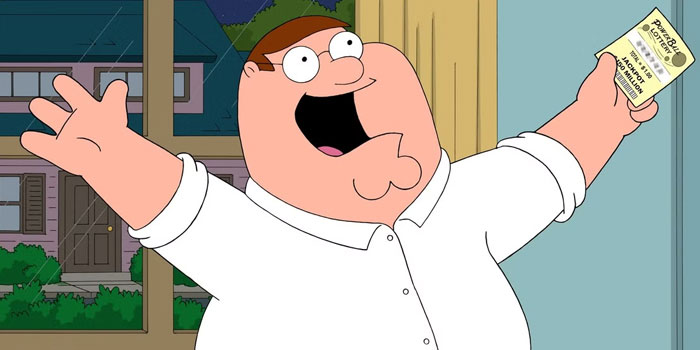
Image credits: Fuzzy Door
#2 Garfield
Garfield, the chubby, lasagna-obsessed orange tabby cat, has captured hearts since 1976 when he first appeared in a comic strip by creator Jim Davis. Described as fat, lazy, sarcastic, and narcissistic, he’s also lovable and endearing.
Speaking in May 2024 to Life, Jim Davis suggests the chunky cat’s enduring appeal is due to his relatability and reliability (3). In Davis’s words, “We’re made to feel guilty for overeating, not exercising, and over-sleeping.” He suggests that Garfield helps alleviate that guilt by openly enjoying some of life’s vices. He continues, “When someone laughs at a Garfield gag, it’s because they’re thinking, ‘Isn’t that true?!’”
With iconic musings like “I hate Mondays” and his penchant for naps, it’s no wonder audiences see themselves in Garfield.
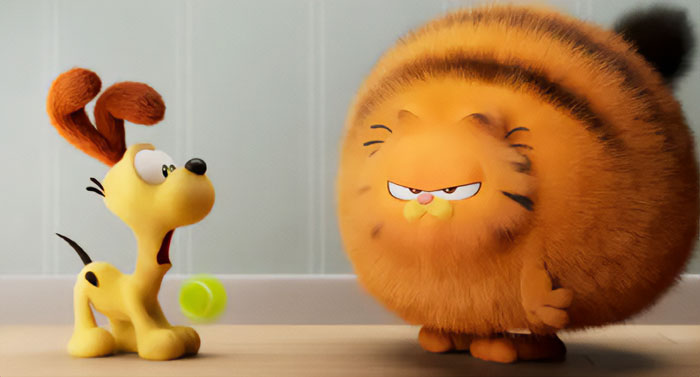
Image credits: Sony Pictures
#3 Eric Cartman
Eric Cartman is one of the main characters, alongside his friends Stan, Kenny, and Kyle, of the adult series South Park which has aired since 1997. The show follows the many misadventures of the fourth-grade boys navigating school and life.
Cartman is rude, obnoxious, impulsive, intolerant, and demanding. He’s also sexist and racist. We could go on. NPR referred to Cartman as “America’s Favorite Little $@#&*%” and an “entrepreneur, conman, and … juvenile evil doer” (4).
With such unpleasant qualities, it’s a mystery why the tubby Cartman persists as a fan favorite. In his conversation with NPR, the show’s co-creator, Trey Parker, suggests that Cartman’s ability to say or do whatever he wants makes him the show’s star.
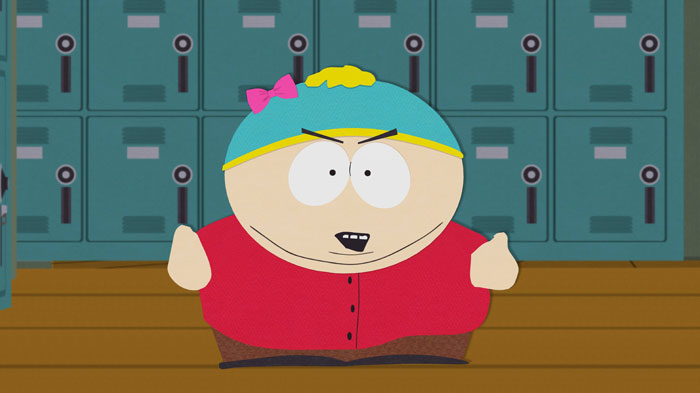
Image credits: South Park Digital Studios LLC
#4 Winnie The Pooh
Winnie the Pooh has endured as a household name for decades. The honey-loving ursine is thoughtful, friendly, and well-meaning. Pooh describes himself as a “bear of very little brain,” expressing the simplicity of his character.
However, despite his self-described lack of intelligence, Pooh offers plenty of wisdom that resonates with audiences of all ages, spanning multiple generations. With phrases like, “Sometimes people care too much, I think it’s called love,” it’s unsurprising that Pooh continues to warm the audience’s hearts.
Despite his worldwide popularity, Pooh Bear also draws some criticism. For instance, the 2018 film Christopher Robin was banned in China because depictions of Winnie the Pooh are often used to satirize China’s president, Xi Jinping (New Statesman, 2018) (5).
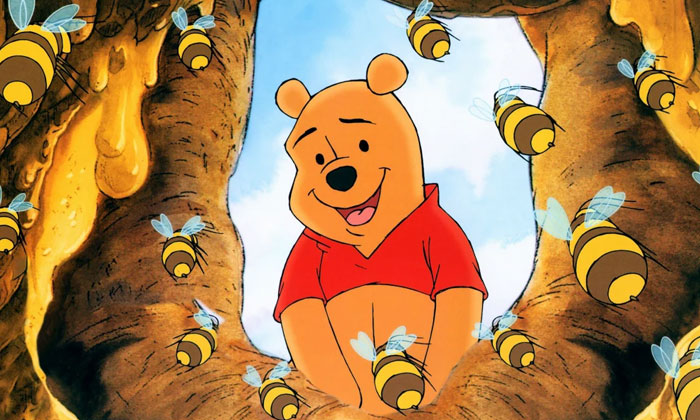
Image credits: Walt Disney Studios
#5 Patrick Star
Patrick Star is an overweight pink starfish from the wildly popular Nickelodeon series SpongeBob SquarePants and his short-lived spin-off, The Patrick Star Show. He and his best friend, SpongeBob, live in the underwater city of Bikini Bottom.
Like several other fat cartoon characters, Star is best known for his work-shy attitude and lack of intellect. However, he does show flickers of insight with sporadic phrases like, “Knowledge can never replace friendship. I prefer to be an idiot.”
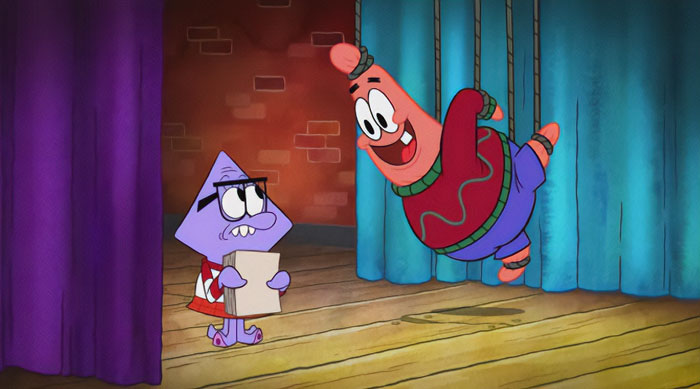
Image credits: Nickelodeon Animation Studio
#6 Fred Flintstone
The Flintstones were introduced to audiences in 1960 as the first primetime animated sitcom. Alongside his wife Wilma and their daughter Pebbles, The Flintstones are a cave-dwelling, modern stone-age family living in the town of Bedrock. Fred Flintstone has proved to be a popular chubby character that has stood the test of time.
As one of the most famous cartoon characters, Fred appeals to both children and adults. He’s loud, irritable, impatient, and sometimes childish. However, he’s also loving and a good husband, father, and friend. He is best known for his trademark exclamation, “Yabba-dabba-do.”
GQ recognized Fred’s cultural impact, describing him as “one of America’s greatest cultural exports” (6). Despite his shortcomings, the prehistoric patriarch inspired European dance acts, German films, and fashion designers.
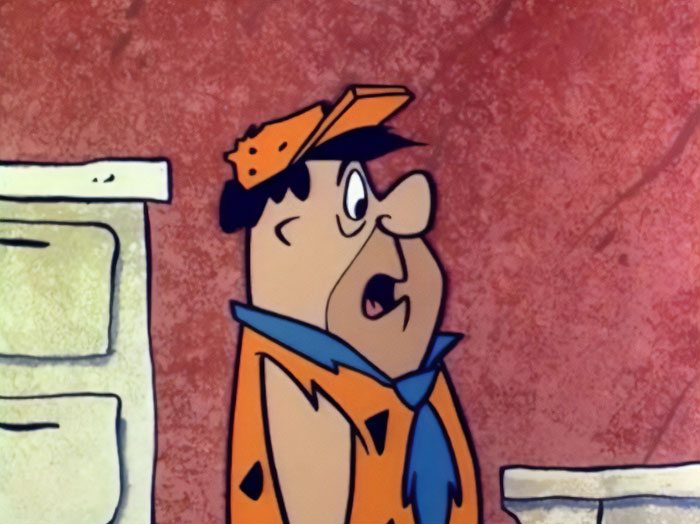
Image credits: imdb.com
#7 Pumbaa
Pumbaa: the first and only Disney character with flatulence. Besides his gassiness, he is best known for being the plumper other half of Timon and for his friendship with Simba from The Lion King franchise.
With his trademark phrase, “Hakuna Matata,” Pumbaa embodies its meaning as he rarely lets anything worry him. He’s friendly and kind and finishes Timon’s sentences with plenty of comic relief.
Amusingly, the weighty warthog’s gaseous qualities were not part of the original story. Nathan Lane, who voiced Timon in the first two animated films, revealed to Entertainment Weekly in May 2024 that Ernie Sabella (the original voice of Pumbaa) would employ fart noises to keep him entertained, “he would make fart sounds to make me laugh. And they eventually incorporated that into the character and the song” (7).
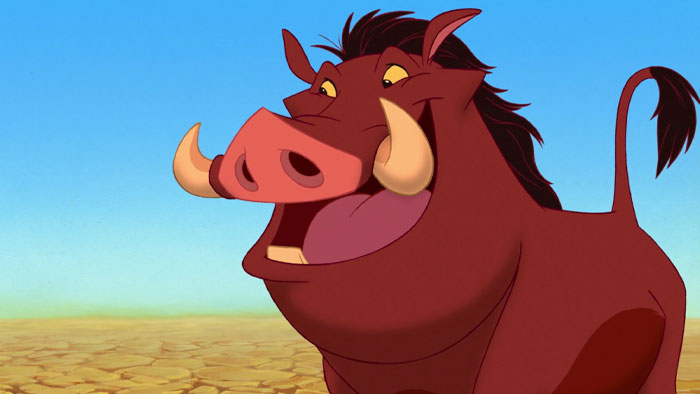
Image credits: Walt Disney Studios
#8 Homer Simpson
Since 1987, the portly Homer Simpson has been a regular household name. As the bumbling patriarch in the adult sitcom The Simpsons, Homer is the husband of Marge and the father of Bart, Lisa, and Maggie.
In 2007, The Sunday Times hilariously described Homer as a “superficially bad but ultimately good father, a fat, cowardly but loving failure” (1). Despite his flaws, Homer’s endearing nature lies in his love for his family as he (eventually) does the right thing for his wife and children.
For decades, Homer’s dim-witted behavior has made him relatable and entertaining for audiences. He offers humorous commentary on an average life with quotes like, “Who would have guessed reading and writing would pay off?”
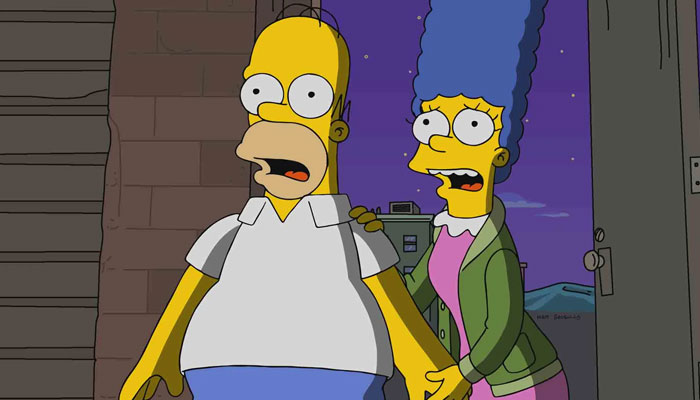
Image credits: Gracie Films
#9 Chief Wiggum
Chief Wiggum, another character in the long-running series The Simpsons, is Springfield’s donut-loving police chief. Surprisingly, or perhaps unsurprisingly, Wiggum’s portly character was based on a pig.
In a 2018 interview with Entertainment Weekly, The Simpsons creator Matt Groening confirmed Wiggum’s porcine inspiration. He said that “his voice is an homage to Edward G. Robinson. The fact that the police chief looks like a pig and talks like a gangster is our idea of deft social satire” (9).
Groening also reveals that Wiggum is “dumber and fatter” than Homer. Writers of Wiggum must be doing something right, though. Groening disclosed that police regularly (and worryingly) express how true to life Chief Wiggum is.
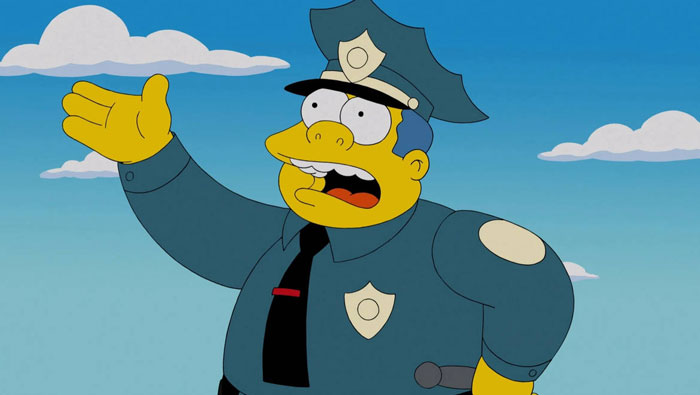
Image credits: Gracie Films
#10 Cow
The suitably named Cow, from Cartoon Network’s Cow and Chicken, first appeared in 1997. Strangely, Cow has human parents and a biological older brother, who is a chicken. He’s called, you guessed it, Chicken. Throughout the series, Cow and Chicken embark on many bumbling misadventures while trying to avoid their nemesis, Red Guy.
Cow is a simple, big-hearted, big-bodied 7-year-old bovine who loves nothing more than playing with her toys. Like any 7-year-old, Cow struggles with problems at school and family life.
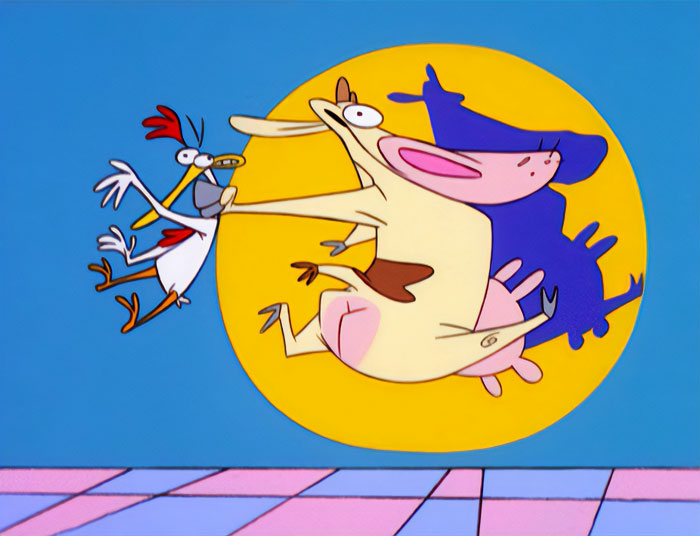
Image credits: imdb.com
#11 Penguin
Oswald Chesterfield Cobblepot, better known as Penguin, is one of the many villainous counterparts of Batman in the DC Universe. The animated version of Penguin first appeared in Batman: The Animated Series in the early 1990s.
Typically, Penguin wears a formal tuxedo and sports a monocle and top hat. His weapon of choice is an umbrella. Unlike many other Batman villains, Penguin is sane but still dangerous. He’s also refined, erudite, and strives to be respected by the influential elite of Gotham City.
With his bird-like appearance, Penguin uses plenty of humorous avian quips to entertain audiences. Phrases like, “I’ll clip your wings, you flying rodent!” make him a memorable mastermind.
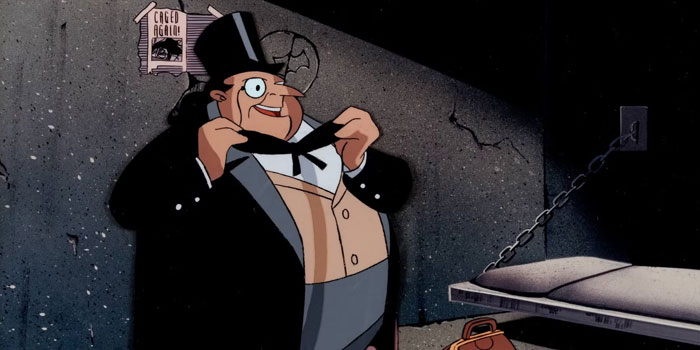
Image credits: Warner Bros. Animation
#12 Uncle Iroh
Uncle Iroh, sometimes called General Iroh, first appeared on screen in Nickelodeon’s Avatar: The Last Airbender in 2005 and its subsequent spin-off series.
Often considered one of the show’s most beloved characters, the handsome, elderly Uncle Iroh is wise, wholesome, funny, and laid-back. Despite these qualities, he’s also a fierce opponent of injustice.
Uncle Iroh’s calm, gentle demeanor is evident when he offers advice to his young nephew. He wisely states, “Perfection and power are overrated. I think you are very wise to choose happiness and love.” Iroh captivates a wide range of audiences with his wisdom and tender disposition.
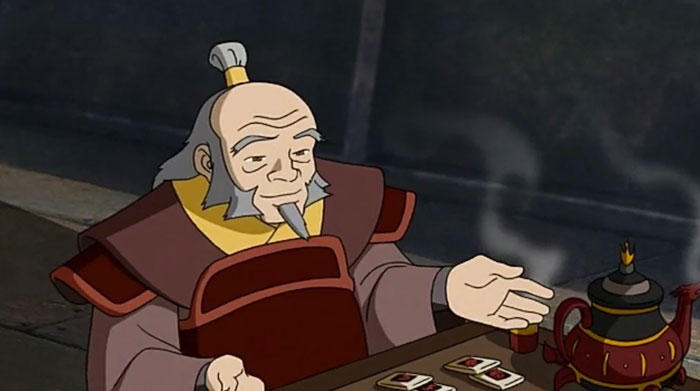
Image credits: Avatar Studios
#13 Frankenstein
Frankenstein, from the Hotel Transylvania franchise, first appeared in 2012. Frankenstein is better known as “Frank” and is best friends with Dracula. Frank has large limbs, light-blue skin, green eyes, and black hair. He’s also soft-spoken and offers plenty of humor.
Frank is kind, gentle, laid-back, and friendly, unlike his namesake. However, like his namesake, he also fears fire and avoids it at all costs, with an iconic statement, “Fire bad.”
While Frank may have a big body, he has an even bigger heart, making him an audience favorite.
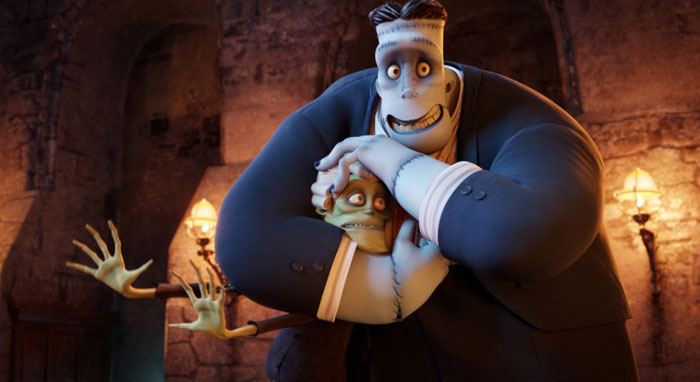
Image credits: Sony Pictures Animation
#14 Po
Obviously, our favorite, Po is the main character from the Kung Fu Panda franchise. First introduced in 2008, Po is an oversized, lovable giant panda adopted by a goose, Mr Ping.
Po can first be described as an overweight, clumsy panda who dreams of nothing more than becoming a Kung fu master. However, his enthusiasm, determination, supportive nature, and eventual acceptance of his identity endear him to audiences. As he states, “I’m not a big fat panda; I’m THE big fat panda.”
Learning to accept yourself for who you are is a valuable lesson Po teaches that resonates with fans of all ages.
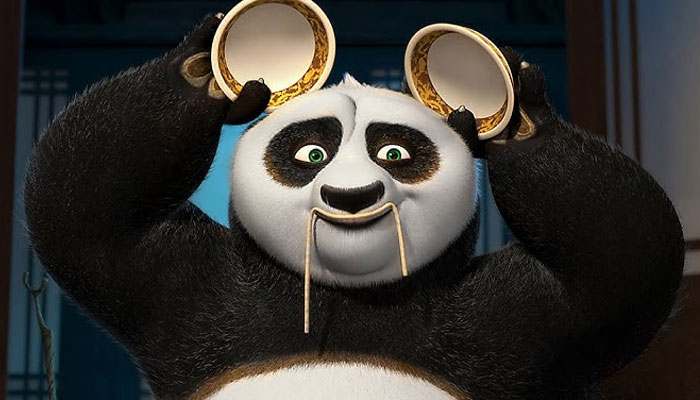
Image credits: DreamWorks Animation
#15 Shrek
With his large and in charge attitude, Shrek first burst onto the scene in 2001 with the film of the same name. Alongside his friends Donkey and Fiona and a whole raft of fairy tale characters, Shrek has become one of the most iconic fat cartoon characters in recent history.
Shrek, an irritable, green ogre, should be, by nature, the antihero. He is initially surly, ugly, and borderline mean. However, through tremendous efforts by the characters around him, especially Donkey, we see the kinder, gentler Shrek we all know and love.
With his oft-quoted phrase, “Ogres are like onions,” audiences did not expect to find the relatable hero they did in a character like Shrek. He reminds us that we shouldn't be so quick to judge others. Sometimes, a tough exterior is just a defense mechanism.
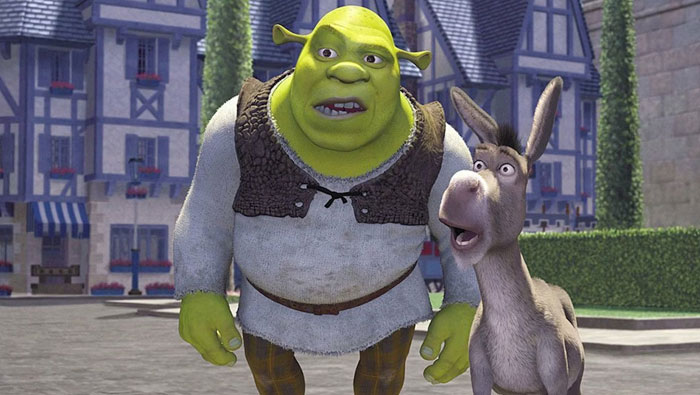
Image credits: DreamWorks Animation
#16 Baymax
Baymax first appeared in Marvel Comics, though he is most recognizable as the robot in Disney’s animated film Big Hero 6. Baymax’s character is an inflatable healthcare robot designed to support patients.
Baymax is also wise and gentle, unlike his fat character counterparts, like Homer Simpson or Peter Griffin. He offers simple, poignant advice to his friends, such as, “It is alright to cry.”
Throughout Big Hero 6, Baymax’s tender nature is highlighted through the emotional support he offers to other characters, particularly Hiro. He helps Hiro to mourn and process grief while showcasing the importance of friendship.
Baymax’s human capacity for love leaves a lasting impression on fans of all ages.
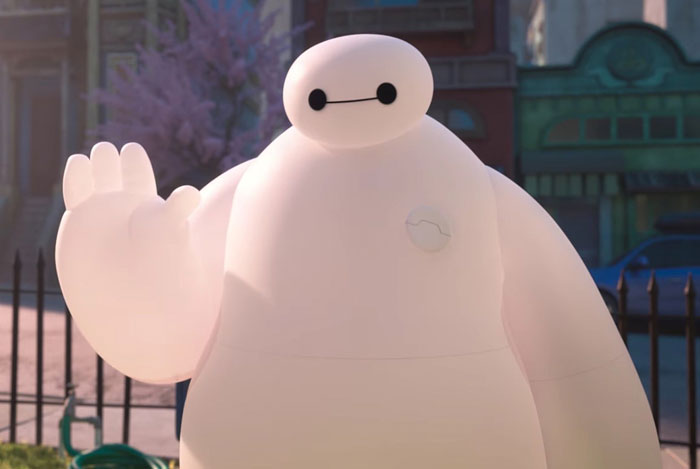
Image credits: Walt Disney Animation Studios
#17 Muriel Bagge
Muriel Bagge is a heavy-set, kind-hearted, elderly Scotswoman from the animated show Courage the Cowardly Dog. Alongside the show’s titular character, Courage, Muriel lives with her cantankerous husband, Eustace. The show aired from 1999 to 2002, with many spin-offs and crossover specials.
Throughout the show, Muriel’s kindness and empathy are emphasized. Not only does she rescue the abandoned puppy she named Courage, but she tries to see the best in everyone. However, this naivety often leaves her vulnerable to the show’s multitude of villains and always just one step away from trouble.
Muriel’s strength, gentleness, and compassion endear her to a broad fan base. Furthermore, her favorite thing is to sit in her rocking chair with Courage on her lap and watch television – the ideal activity for dog owners worldwide.
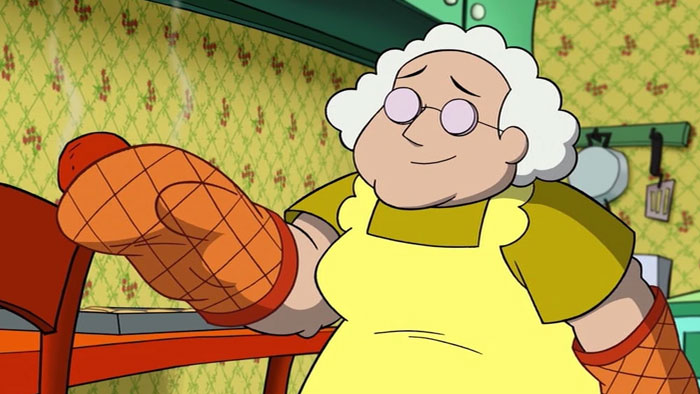
Image credits: Stretch Films
#18 Fat Albert
The brainchild of Bill Cosby, the obese Fat Albert is the main character of Fat Albert and The Cosby Kids, which aired from 1972 to 1985.
Albert deviates from the norms of a typical fat character with his athleticism and fondness for playing sports. Fat Albert was intentionally written as an alternative to the archetypal, funny fat character.
Speaking to The New York Times in 2013, Bill Cosby stated, “I changed Albert, making him the leader and giving him the intelligence” (8). Albert was the conscience of the Junkyard Gang, a far cry from being the typical comedic relief of a fat character. Known for his iconic catchphrase, “Hey, hey, hey!” Fat Albert broke both race and weight stereotypes.
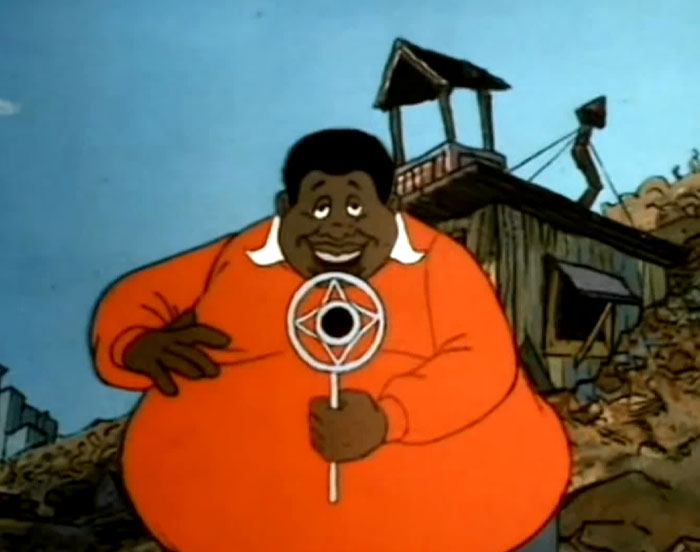
Image credits: imdb.com
#19 Chris Griffin
Chris Griffin is the middle child of Peter Griffin from the popular animated television series Family Guy. Like his father, he is pictured overweight and slow-witted. However, he is considered slightly more intelligent than his father.
Like the rest of the Griffin family, Chris is often spiteful and self-centered. Despite these qualities, he also shows glimpses of kindness and compassion.
Audiences likely relate to Chris through some of the storylines provided to him. For example, throughout the series, Chris deals with insecurities about his weight, a common issue for many people. He also struggles to cope with the changes that his teenage body goes through, and he endures many stereotypical adolescent problems, such as living up to his father’s expectations and dating.
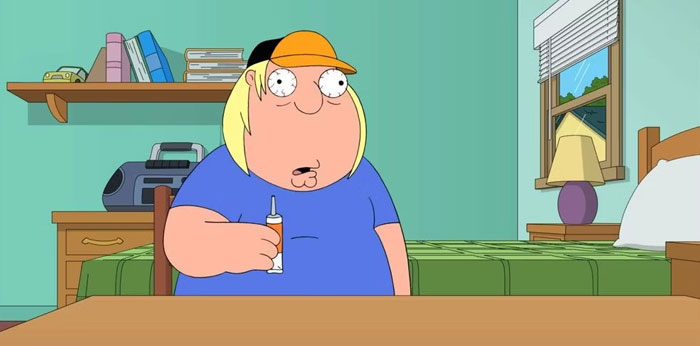
Image credits: Fuzzy Door
#20 The Blob
Fred Dukes, more aptly called The Blob, is a character from Marvel Comics who is an adversary of the X-Men. Although his origins are in X-Men comics, he made his animated debut in the 1990s on X-Men: The Animated Series.
The Blob features an immense frame; he’s tall and wide and uses this to his advantage. In one episode, he declares, “I’m gonna flatten these X-Clowns by sitting on ’em.”
His grotesquely large figure makes him the physically strongest cartoon character. It also allows him to deflect the X-Men easily; they often get their fists stuck in his massive gut.
Throughout the show, The Blob frequently burps between battles with the X-Men and indulges in copious food, like ice cream and burgers.
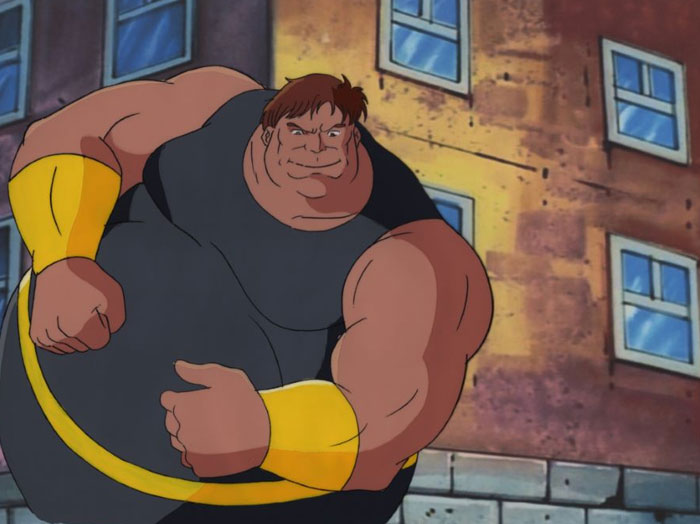
Image credits: Marvel Entertainment
The Evolution of Fat Cartoon Characters
Fat characters have been a core element of animated cartoons for decades. Indeed, Fred Flintstone has been around since 1960, and an animated Winnie the Pooh debuted in 1966.
In the beginning, fat characters emphasized existing stereotypes associated with being overweight, such as lethargy, carelessness, and a lack of self-discipline (National Library of Medicine, 2023) (10). These early characters also typically reinforced stigmas that people struggling with obesity are either social failures, nurturing figures, sidekicks to their thinner counterparts, or just there for comic relief.
However, some historical characters, like Fat Albert, actively tried to break down these typecasts by giving the fat characters positive attributes. More recently, many heavy-set main cartoon characters, like Po and Shrek, ensure their body types don’t stop them.
Why Fat Cartoon Characters Resonate with Audiences
Typically, television and films, both live-action and animated, don't proportionally represent all body types. For this reason, fat cartoon characters often click with audiences because they are relatable.
Positively portraying heavier body types in media is crucial because such a high proportion of the population is overweight. According to The Representation Project, children begin having opinions about their bodies by age three (11). The Project emphasizes that characters with big body types must be positively depicted to combat negative body image.
Fortunately, cartoon creators seem to be embracing this and are introducing characters with more shapely bodies that don’t adhere to traditional fat stereotypes. Recent characters like Uncle Iroh, Shrek, Po, and Frankenstein are helping to break the mold of the typical fat cartoon characters.
References
- “There’s nobody like him...except you, me, everyone.” The Sunday Times, July 8, 2007 | https://web.archive.org/web/20080515211629/http:/entertainment.timesonline.co.uk/tol/arts_and_entertainment/tv_and_radio/article2042236.ece
- @BBC. “Seth MacFarlane performs his Family Guy voices | The Graham Norton Show.” YouTube, May 30, 2014 | https://www.youtube.com/watch?v=B6vmGabgzH4
- McIntyre, Gina. “Garfield: The Story Behind the Coolest of the Cats.” Life, May 3, 2024 | https://www.life.com/arts-entertainment/garfield-the-story-behind-the-coolest-cat/
- Rovner, Julie. “Eric Cartman: America’s Favorite Little $@#&*%.” NPR, April 5, 2008 | https://www.npr.org/2008/04/05/89375695/eric-cartman-americas-favorite-little
- “Leader: The enduring cultural influence of Winnie the Pooh.” The New Statesman, August 22, 2018 | https://www.newstatesman.com/politics/2018/08/leader-enduring-cultural-influence-winnie-pooh
- Bilandic, Michael M. “How Fred Flintstone Became one of America’s Greatest Cultural Exports.” GQ, September 25, 2024 | https://www.gq.com/story/fred-flintstone-respecters
- Lenker, Maureen Lee. “Nathan Lane and Ernie Sabella reveal the origin of Pumbaa’s farts in The Lion King.” Entertainment Weekly, May 22, 2024 | https://ew.com/nathan-lane-ernie-sabella-reveals-origin-pumbaa-flatulence-the-lion-king-8652054
- Itzkoff, David. “Hey, Hey, Hey: Bill Cosby on ‘Fat Albert,’ Yesterday and Today.” The New York Times, June 12, 2013 | https://archive.nytimes.com/artsbeat.blogs.nytimes.com/2013/06/12/hey-hey-hey-bill-cosby-on-fat-albert-yesterday-and-today/
- Canfield, David. “The Simpsons exclusive: How 10 Iconic characters got their names.” Entertainment Weekly, June 12, 2018 | https://ew.com/books/the-simpsons-springfield-confidential-excerpt/#5948017%EF%BB%BF
- Fulton, Melody, et al. “Obesity, Stigma, and Discrimination.” National Library of Medicine. October 26, 2023 | https://www.ncbi.nlm.nih.gov/books/NBK554571/
- “The Importance of Fat Representation.” The Representation Project, January 9, 2023 | https://therepproject.org/we-need-better-fat-representation/#:~:text=Children+begin+to+have+opinions,body+image+and+diet+culture







